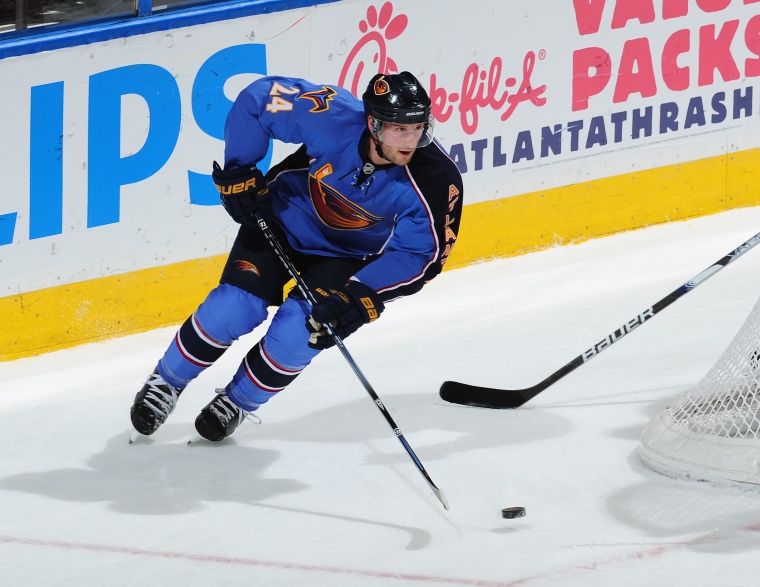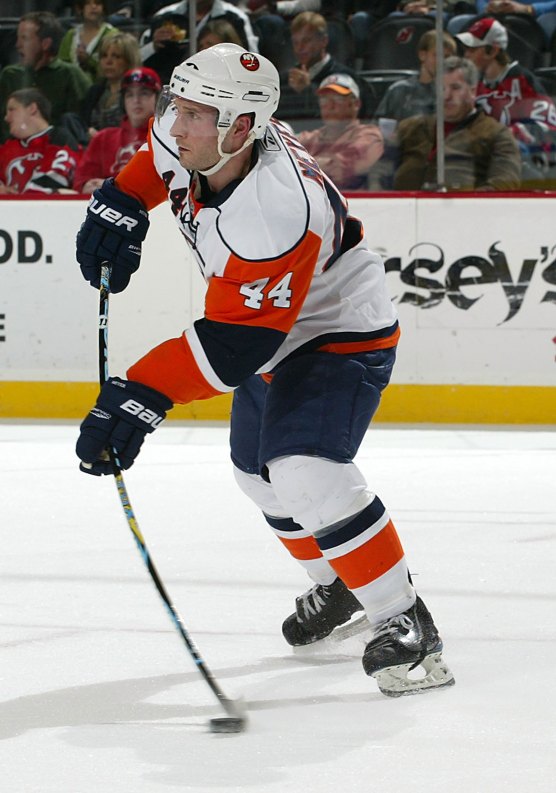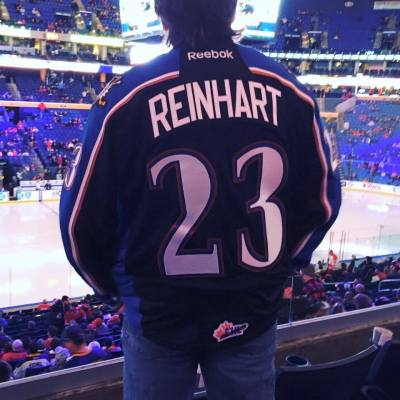What always stands out in my mind about Freddy Meyer was the size that he played the game despite being diminutive physically; he never backed down from anyone. At 5-feet, 9-inches and roughly 190lbs., Meyer’s stature is significantly less than that of most NHL defensemen throughout the 2000s when he played. But to illustrate my point of playing much larger, during a December 23rd, 2010 game in Boston against the Bruins, in what would be his last NHL season, Meyer absolutely dropped one of the most intimidating players in the game, former Bruin Milan Lucic, with a big hit; stood him right up and belted him to his backside. Meyer did this despite a rash of his own injuries that season which limited him to only 15-games. He did it despite the fact that there were less than five minutes left in the game; he could have eased up or chose the easy away around the boulder to thus avoid any conflict – but that just isn’t in Meyer’s character. And he did it despite Lucic being five inches taller than him and outweighing Freddy by forty pounds – as if to invoke a David versus Goliath tale of his own. For Freddy Meyer, any so-called lack of size never held him back in the least.

Born January 4th, 1981 in Sanbornville, New Hampshire, Freddy did not take an immediate interest in hockey when he was a kid. “I started at age 6”, he says. “My brother started playing the year before me, but I didn’t want to play. But after spending the first year watching him I decided that I wanted to give it a try”. Little would Meyer realize at the time that the initially reluctant decision to play hockey would eventually lead him to playing four years collegiately, nine more years professionally, and for the United States at multiple international competitions. “I lived in a small town in New Hampshire, and there were limited opportunities to play besides the local youth program. I played there for two years, and then moved onto a local select hockey team that would compete in Massachusetts.
Being from the New England area Meyer naturally became a Boston Bruins fan, as well as finding a hero in a Boston and true hockey legend. “My dad shared season tickets to the Bruins with a few friends, so we went to several games a year growing up. Being a defenseman, I always enjoyed watching and admiring Ray Bourque”. There are at least some comparisons that can be made between the Hall of Famer Bourque, and the way that Meyer may have mirrored his game similarly. Throughout his own career Meyer moved the puck very well, particularly out of his own end. He also excelled on specialty teams, and was a regular along the blueline on powerplays.
While in high school, Freddy Meyer became enrolled in the United States National Team Development Program. Initially becoming involved with the program for the 1997-98 campaign, Meyer showcased his skills alongside fellow countrymen that also would make it to the NHL, including Andy Hilbert, Rick DiPietro, John-Michael Liles, Jordan Leopold, David Tanabe, and more. In 37-games with USNTDP team that first year, Meyer put up 11-goals and 10-assists. And once again to prove that a lack of size never kept him from robust play, Meyer led the team in penalty-minutes that year with 113-PIMs.

Electing to continue his hockey career collegiately, Freddy would enroll at Boston University where he would continue to develop his game and would begin attaining multiple accolades. “My decision came down to the University of New Hampshire, BU, and the University of Maine. It was obviously a tough decision, but having the opportunity to play in Boston under head coach Jack Parker was an opportunity that I couldn’t pass up”. Having retired as head coach of the Terriers after the 2012-13 season, his 40th, Jack Parker finished his coaching career as one of the most decorated college hockey coaches of all time. A three-time NCAA Tournament champion, a record 24 NCAA Tournament appearances, the records for Most Wins with One School, Most Frozen Four Appearances, Most Beanpot Victories, as well as seemingly countless other honors, it was not too difficult to see why Meyer would elect to go to BU and play under Parker’s leadership.
Meyer and his Terrier teammates would find themselves obtaining both adversity and success. He tells me that, “three out of my four years we lost the game that would have put us in the Frozen Four – those stick out as missed opportunities. But obviously winning three out of four Beanpots was pretty special”. The Beanpot is an ice hockey tournament that has been in place since the 1952-53 season, and sets the stage annually for bragging rights amongst the four major college hockey schools in the Boston area; Meyer’s BU, the Boston College Eagles, the Harvard University Crimson, and the Northeastern University Huskies. Winning those three Beanpots is definitely an exceptional feat for Meyer and his teammates. In addition to those successes, Freddy Meyer was also heralded as a member of the 1999-00 All-Hockey East Rookie Team, alongside future NHLers Rick DiPietro, Ron Hainsey, and Krys Kolanos. Other collegiate honors include being named to the 2002-03 All-Hockey East First Team and the ACHA East First-Team All-American.
Freddy Meyer was never drafted by an NHL team. In fact, the thought of playing in the top professional league did not seem something attainable to him until his first season of pro hockey. “I wasn’t drafted and had to battle for every chance that I had. I didn’t realize the NHL was close until my first year pro”. The Philadelphia Flyers took note of Freddy’s hard work and determination, and ended up signing him as a free agent in May 2003. “They (the Flyers) were the most interested and it appeared as the best opportunity. Being a 5-foot-9 defenseman in 2003 before the lockout and the rule changes, there weren’t a lot of teams interested. It just inspired me to train harder and keep battling”.

The 2003-04 hockey season, Meyer’s first professionally, would see him spend almost the entire season with the Flyers’ American Hockey League affiliate, the Philadelphia Phantoms. With head coach John Stevens and assistant coach Kjell Samuelsson at the helm, Meyer put together a very promising first season, tallying 14-goals and 14-assists for 28-points in 59-games. Freddy’s 14-goals were second only to John Slaney for goals scored by a defenseman on the hockey club. With 46-wins, 25-losses and 7-ties to go with 2-overtime losses, the Phantoms would capture the AHL’s East Division, only to lose to their division and cross-state rival the Wilkes-Barre/Scranton Penguins in the second round of the playoffs. Regardless, for a player never drafted to play professionally, that first season demonstrated that Freddy could indeed play at an elite level. And he would even have one late season opportunity to do so in “The Show”.
“I remember my first NHL game. It was a surreal feeling. The whole experience went by so fast”. Freddy Meyer would make his NHL debut, a single game appearance with the parent club Flyers, in early March 2004. A 23-year old rookie, Meyer would take twenty shifts on the ice that game, logging over 15-minutes of ice time and getting a shot on goal. Though brief, Freddy Meyer had made it into an NHL hockey game; the first of what would be many more to come. “It was great to get a taste of the experience”, he says, “and realize that the ultimate goal wasn’t far away”.
The National Hockey League would go into a lockout for the 2004-05 season. Though this would only stand as a temporary setback in Freddy’s continuing the start of his NHL career, the lockout provided him another full season of AHL hockey with the Phantoms, and it would be a most memorable one. Accompanied by future NHL stars R.J. Umberger, Joni Pitkanen, Patrick Sharp and Dennis Seidenberg, Meyer and the Phantoms would reel off another superb season in which they amassed a record of 48-25-3-4, and would finish second in the East Division. More importantly however, the Phantoms went on a tear through the AHL playoffs, this time defeating rival Wilkes-Barre/Scranton in the second round of the playoffs, finishing them off in five games, and then making it all the way to the Calder Cup Finals championship against the Chicago Wolves. The Phantoms would make short-work of the Wolves in the Finals by sweeping them in four games straight, and outscoring them 10-goals to 4. Meyer was widely recognized for his role in capturing the Calder Cup, as he appeared in all 21-Phantoms’ playoff games, putting up 3-goals and 9-assists along the way. The proof was there for the Flyers hierarchy, and the following season would see Freddy join them for what would be the second fullest season of his career.

In all, Freddy Meyer would play in the Flyers’ organization for three and a half seasons, between the Flyers and the Phantoms, before a December 16th, 2006 trade with the New York Islanders would see him shipped to Long Island with a 2007 3rd-round draft pick in exchange for veteran defenseman Alexei Zhitnik. Freddy’s time with the Flyers contains some of his best hockey memories from his career. He recalls, “playing on the powerplay in PA with Peter Forsberg, and thinking to myself ‘what am I doing here?'”. When I ask him if any veterans took him under their wing during his time with the Flyers, he says, “I played with a lot of great players. Eric Desjardins jumps out in my mind. It wasn’t his spoken words, but his work ethic and commitment level. We trained together for a couple summers in Philly, and he was amazing at his age”.
Upon being traded to the Islanders in 2006, Freddy Meyer would go onto play four more seasons in the National Hockey League, including a second stint with New York after a brief stop in Phoenix with the Coyotes. After his final NHL season in 2010-11 with the Thrashers, Meyer opted for a year in Sweden with MODO Hockey of the Swedish Elite League; his final year of the professional game. Freddy tells me, “I loved my experience of playing in the Swedish Elite League. We were in Sweden as a family, and have a lot of great memories from the six months we spent there. It’s great hockey, and an unbelievable quality of life”. Former NHL teammates Rob Schremp (New York Islanders) and Mikael Tellqvist (Phoenix Coyotes) also played with MODO that season too.
Unfortunately though, Freddy would call it a career shortly after his lone season with MODO. “I had had a season ending concussion in Atlanta, and then the following season in Sweden I received another concussion. At that point, we made a decision as a family that it was time to step away from the rink”. In 281-regular season games in the NHL, Freddy Meyer amassed 20-goals and 53-assists for 73-points; solid offensive career numbers for any defenseman to have played a similar amount of games. But the career statistic that comes most to mind (at least for me) about Freddy is that in those 281-games, he also compiled 155-penalty minutes. That number speaks to a fearless style of play that he embodied, and is at least a statistical insight into Meyer’s play as a constant battler on the ice and in his own end. Besides the Lucic play while he was with the Thrashers, if you ever had the pleasure of watching Freddy on the ice, you would have seen multiple instances of him utilizing his 5-foot, 9-inch frame to place a hit on an opposing player, thus neutralizing a scoring rush by the opponent; it was always a pleasure to watch him play.
Team USA called upon Freddy too in three separate international tournaments; the 1999 World U18 Championships in Germany, the 2001 World Junior Championships in Moscow, Russia, and then the 2006 World Hockey Championships in Riga, Latvia. “It’s an incredible feeling to wear the Red, White and Blue”, Freddy says and, “nothing compares to the experience of competing with your fellow countrymen”.
After retiring as a player, Freddy became thoroughly involved in coaching the game instead. “We returned to the USA, and I started looking for job opportunities. I was hired by the Los Angeles Kings, and worked two seasons for their minor league affiliate the Manchester Monarchs as an assistant coach. I am currently going into my third year being the head coach of a Tier-3 junior team in the Greater Boston area, the East Coast Wizards. Additionally, I started Dream Big HockeyStars, where we run camps, clinics and private lessons for aspiring players”.

As a player, Freddy Meyer exemplified a quality that is dear to me personally, and that made a him a very successful hockey player – the concept of outworking his opposition. I ask Freddy what the most important thing is that he has learned throughout his hockey career. “Set your sights high and Dream Big. I was an undersized defenseman that wasn’t drafted. I needed to outwork my competition in order to have success. Never give up, and continue to push yourself outside of your comfort levels”. It is obvious to me that Freddy Meyer indeed set his own sights high and dreamed big – he played nearly 300 games in the National Hockey League with strong success, despite anything that would have inclined himself or naysayers to think otherwise. He outworked the opposition, whether it was physically out on the ice, or whether it was any doubt that may have crept in – Freddy kept it all at bay. Freddy Meyer’s career is an inspirational one consisting of big dreams that came true.
If you would like to learn more about Freddy Meyer’s hockey program, please visit his website at http://www.dreambighockeystars.com


